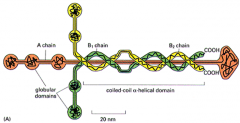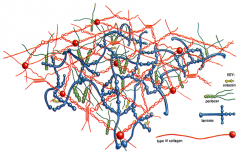![]()
![]()
![]()
Use LEFT and RIGHT arrow keys to navigate between flashcards;
Use UP and DOWN arrow keys to flip the card;
H to show hint;
A reads text to speech;
21 Cards in this Set
- Front
- Back
|
How is connective tissue assembled? |
- synthesis as a part of normal tissue metabolism - synthesis in response to injury - repair (stimulated by local and systemic factors) |
|
|
How is connective tissue degraded? |
- by specialised proteolytic enzymes involved in ECM degradation - Collagenases, Gelatinases, Stromelysins, Matrilysins = metalloproteinases (MMPs) - Proteoglycanases (ADAMTS) |
|
|
What does ADAMTS stand for? |
- A disintegrin and metalloproteinase with thrombospondin motifs |
|
|
How are these degradative enzymes regulated (action/expression)? |
- Cytokines = interleukins, interferon and others - mechanical loading - bacterial lipopolysaccharide (LPS) - signals from the ECM |
|
|
What cell-matrix interactions: |
- cell adhesion linking ECM components (especially glycoproteins) with the cytoplasmic components (the cytoskeleton) of connective tissue cells |
|
|
What is cell adhesion important for? |
- mechanical strength - tissue integrity - cell migration - mechantransduction - cell growth, differentiation and survival |
|
|
What can happen if there is a disruption in cell-to-ECM adhesion? |
- mutation in type VII collagen - Epidermolysis bullosa - skin and/or mucous membranes blister in response to mechanical trauma with extreme ease |
|
|
Examples of matrix glycoproteins involved in cell/matrix interactions: |
- Fibronectin - Laminin |
|
|
What are the features of fibronectin? |
- occurs in all tissues of the body - large modular glycoprotein - composed of 2 subunits linked by disulphide bonds |
|
|
What are the two forms of fibronectin? |
- Insoluble aggregates in association with other ECM components - a soluble form in plasma |
|
|
Laminin (image) |

- |
|
|
Structure of Basal Lamina (image) |

|
|
|
Transmembrane linkers in non-epithelial cells have three domains: |
- extracellular domain = binds to another linker molecule on the surface of another cell or to ECM molecules e.g. collagen, proteoglycan - Transmembrane domain = hydrophobic - Cytoplasmic domain - binds to cytoskeletal protein |
|
|
What are integrins? |
- ECM receptors on the cell surface (ligands are called ligands) - large family of non-covalently associated heterodimers composed of α and β subunits - links ECM components to the cytoskeleton - active cell signalling pathway |
|
|
What is the 3D structure of an integrin heterodimer? |
- HEAD and LEG subunits - both needed for ligand binding - both have short cytoplasmic domains involved in signal transduction |
|
|
How do integrins interact? |
- exist in active or inactive form - ligand binding is cation dependent (Ca2+, Mg2+ or Mn2+), happens with a low affinity => present in 10-100 fikd higher concentration - combinations & types of subunits dictate ligand selectivity - recognise specific AA seq in the ligand |
|
|
How is integrin activated? |
- induced by ligand binding or cytoplasmic signals - allosteric changes lead to straightening of the bend & separation of the legs - activation domains within the EGF repeats and PSI domain exposed - separation and conformational changes in the cytoplasmic domain lead to binding of cytoplasmic attachment proteins |
|
|
What are disintegrins? |
- found in venom of vipers - small proteins of less than 80 AAs - act as receptor antagonists - disrupt platelet aggregation and integrin-mediated cell adhesion |
|
|
What is a focal adhesion plaque? |
- integrin clustering - cytoplasmic attachment protein link integrins to actin filaments |
|
|
Signalling through integrins: |
- outside-in-signalling - integrins can transduce a series of signals after ligand binding (cell shape and cell migration, proliferation, survival) - inside-out-signalling - changes in the cytoplasm can regulate ligand binding activity of integrins and ECM assembly |
|
|
The basic principle of cell signalling involves tyrosine kinases |
- integrins belong to the family of hydrophilic receptors that do not have a kinase domain - the signal transduction cascade is activated by cytosolica kinases associated with focal contacts: Focal Adhesion Kinase (FAK), Integrin-linked kinase (ILK) |

